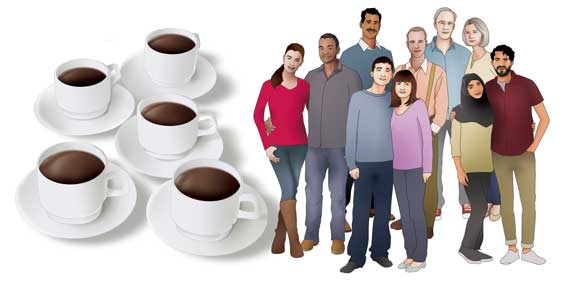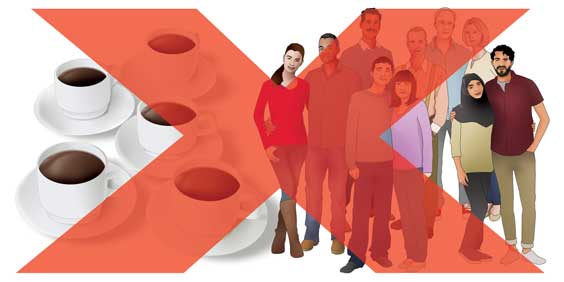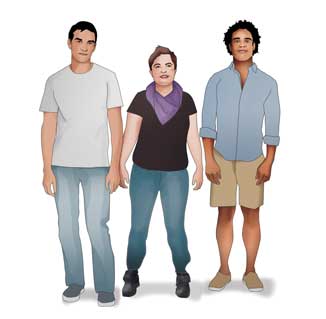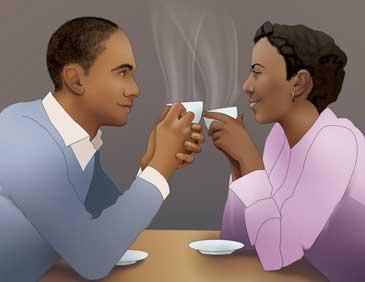Chapter 6. How Would You Know If a Cup of Coffee Can Warm Up Relationships?
6.1
By:
C. Nathan DeWall, University of Kentucky
David G. Myers, Hope College

6.2
Note: You will be guided through the Intro, Design, Measure, Interpret, Conclusion, and Quiz sections of this activity. You can see your progress highlighted in the non-clickable, navigational list at right.
Watch this video from your author, Nathan DeWall, for a helpful, very brief overview of the activity.
6.3

So, how would you know if holding a cup of coffee or other warm beverage can warm up people’s feelings toward those around them? To study this question in your role as researcher, you need to DESIGN an appropriate study that will lead to meaningful results, MEASURE whether people perceive others as friendly and warm, and INTERPRET the larger meaning of your results, considering how your findings would apply to the population as a whole.
We will start by choosing the best research DESIGN. Select the design your study should use to find out if a cup of coffee can warm up relationships.
| A. |
| B. |
| C. |
Click on "Video Hint" below to see brief animations describing Correlational Design, Experiments, and Case Studies.
Video Hint
6.4
Correlational Studies:
Experiments:
Case Studies:
6.5

You have chosen Correlational design, which means you want to examine the association between two or more variables. For example, when testing whether stress relates to having a higher heart rate, researchers would recruit a large group of people and measure their stress levels and heart rates. This allows researchers to determine whether having more stress predicts having a higher heart rate. (It comes as no surprise that yes, higher stress does predict having a higher heart rate.)
Describe below how you would set up your correlational study to determine if a cup of coffee can warm up relationships:
6.6

To use the Correlational design, we could recruit a large group of participants and (1) ask whether they drink coffee and (2) give them an assessment that determines how much friendliness and warmth they perceive in others, and then see if there is a correlation between the two variables. But this study would not help us determine if a cup of coffee can cause people to perceive others as friendly and warm. Many other factors may influence how we perceive others, including our personality traits, whether the people we perceive are strangers or friends, and how much we were taught to pay attention to others’ positive rather than negative characteristics. We need to test whether holding a cup of coffee causes people to perceive others as friendly and warm.
So, CORRELATIONAL IS NOT THE BEST RESEARCH DESIGN for this study. We’d get more helpful results by using a different design. Click “Next” to go back and try again to select the most effective research design.
6.7

You have chosen Case Study as your design. With a Case Study design, you will choose one person or a small group of people, such as a specific group of people from a certain school or town, and then study them in depth.
Of the following options, which one represents the best participant(s) for your case study?
| A. |
| B. |
| C. |
| D. |
6.8

What could we learn from these participant choices?
A small group of people who eat at restaurants every night. This option does not tell you about your participants’ weight or the size of the dinner plates they use. To know whether using larger dinner plates make us fat, you would need to study a group of individuals who have average body weight. This way you can determine whether changing the size of the plates they use causes them to behave in ways that will increase their weight.
A small group of people who are obese. This option tells you about your participants’ weight but not about the size of the dinner plates they use. To know whether using larger dinner plates makes us fat, you would need to study a group of individuals who have average body weight (not just people who are obese), and then vary the size of the dinner plates they use to see if that causes them to increase their weight.
A small group of people who are thin. This option tells you about your participants’ weight but not about the size of the dinner plates they use. To know whether using larger dinner plates makes us fat, you would need to study a group of individuals who have average body weight (not just people who are thin), and then vary the size of the dinner plates they use to see if that causes them to increase their weight.
A small group of people who have average body weight. You were right to choose people who have average body weight, but this option doesn’t tell us about the size of the dinner plates they use. To know whether using larger dinner plates makes us fat, you would need to study a group of individuals who have average body weight, and then vary the size of the dinner plates they use to see if that causes them to increase their weight. Also, you would need to study a large group, not a small group as in this Case Study approach, in order to determine whether the idea of using larger dinner plates making us fat may apply to the larger population.
Trying to choose a sample of participants helps us realize that the CASE STUDY IS NOT THE BEST RESEARCH DESIGN to test this question. We’d get more helpful results by studying large groups of people who can experience normal features of coffee, which would help us apply our results to a broad population.
Click “Next” to go back and try again to select the most effective research design.
6.9

Nice work! You have correctly chosen to use an Experimental design for your study.
Next, you need to choose the most appropriate study participants and consider how you would set up the experiment.
Of the following options, which one represents the BEST setup for your study?
| A. |
| B. |
| C. |
| D. |
6.10
You chose With a group of people who do not have the ability to feel temperature changes, test whether their perceptions of a stranger’s warmth change when they hold a warm cup of coffee.
This group is not the best choice, because you need to recruit people who can experience normal features of coffee, such as its temperature, in order to determine whether a cup of coffee can warm up relationships.
Click “Next” to try again to choose the most appropriate study participants.
6.11

You chose With one group of people who prefer caffeinated coffee and another group of people who prefer decaffeinated coffee, test whether their perceptions of a stranger’s warmth change when they hold a warm cup of coffee.
Having information about coffee preferences does not tell us anything about whether a cup of coffee can warm up relationships.
Click “Next” to try again to choose the most appropriate study participants.
6.12
You chose With one group of people who do not have the ability to feel temperature changes and another group of people of who have a normal ability to feel temperature changes, test whether their perceptions of a stranger’s warmth change when they hold a warm cup of coffee.
This is not the best choice, because you need to focus only on people who can experience normal features of coffee, such as its temperature, in order to determine whether a cup of coffee can warm up relationships in the general population.
Click “Next” to try again to choose the most appropriate study participants.
6.13

Good job! You correctly chose With a group of people who have a normal ability to feel temperature changes, test whether their perceptions of a stranger’s warmth change when they hold a warm cup of coffee.
Now you need to determine how best to MEASURE the relevant behavior or mental process, which in this case is how much people perceive others as friendly and warm.
Consider what you know about experiments. How will you establish an experimental group and a control group so that you can test this question most effectively?
6.14

Of the following options, which one represents the BEST way to measure your target behavior?
| A. |
| B. |
| C. |
| D. |
6.15

You chose Participants hold a warm cup of coffee, read a neutral story about “Linda,” and then answer this question: “Taking all things together, how would you rate Linda on the following characteristics: warm, friendly, caring?” (1=not at all to 7=extremely), but that is NOT CORRECT.
This option would give you only one testing condition. You need to establish an experimental and a control condition.
Click “Next” to try again to select the best way to measure whether people perceive Linda as friendly and warm.
6.16

You chose Participants hold either a warm or cold cup of coffee, read a neutral story about “Linda,” and then answer this question: “Taking all things together, how would you rate Linda on the following characteristics: talkative, clean, detail-oriented? (1=not at all to 7=extremely), but that is NOT CORRECT.
Although you did establish an experimental condition (warm cup of coffee) and a control condition (iced coffee), you measured perceptions of characteristics that are unrelated to friendliness and warmth. Talkative, clean, and detail-oriented people may be friendly or unfriendly, and socially warm or cold. To know whether a cup of coffee can warm up relationships, you would need to measure whether people perceive Linda as friendly and warm.
Click “Next” to try again to select the best way to measure whether people perceive Linda as friendly and warm.
6.17

You chose Participants hold either a warm or cold cup of coffee, read a neutral story about “Linda,” and then answer this question: “Taking all things together, how much do you think Linda enjoys eating foods that provide psychological comfort?” (1=not at all to 7=extremely), but that is NOT CORRECT.
Although you did establish an experimental condition (warm cup of coffee) and a control condition (iced coffee), perceptions of Linda’s attitudes toward comfort food do not tell us anything about perceptions of her warmth and friendliness. To determine whether a cup of coffee can warm up relationships, we need to measure whether people perceive Linda as friendly and warm.
Click “Next” to try again to select the best way to measure whether people perceive Linda as friendly and warm.
6.18

Good job! You correctly chose Participants hold either a warm or cold cup of coffee, read a neutral story about “Linda,” and then answer this question: “Taking all things together, how would you rate Linda on the following characteristics: warm, friendly, caring?” (1=not at all to 7=extremely).
You have correctly chosen to use an Experimental design. You also selected an appropriate sample of participants—a sample of people who have a normal ability to feel temperature changes. You chose an effective way to MEASURE whether a cup of coffee can warm up relationships by assessing how much people perceive others as friendly and warm. And you’ve established both experimental and control conditions.
Similar experiments have shown that a cup of coffee can in fact warm up relationships. People who hold a warm cup of coffee, compared with those who hold a cup of iced coffee, do perceive strangers as more generous and caring (Williams & Bargh, 2008). Other work has shown that such physical warmth also increases our feelings of social connection and trust (IJzerman & Semin, 2009). Physical warmth even activates our brain’s pleasure centers (Inagaki & Eisenberger, 2013)!
Knowing this, you need to consider how you can apply what you’ve learned to the larger population—beyond the people you’ve studied. Consider where you might encounter roadblocks to confidence in your results. What factors might keep you from being able to apply what you’ve learned in a broader context?
6.19

You tested whether holding a cup of warm coffee, compared with a cup of iced coffee, caused people to perceive others as more friendly and warm. There are many factors that could affect whether people perceive others as friendly and warm, and these factors may have nothing to do with the temperature of the coffee they just held! Factors that could interfere with our INTERPRETATION of results are called confounding variables.
Select all of the factors that could affect your confidence about whether holding a cup of warm coffee, compared with a cup of iced coffee, would cause participants to perceive “Linda” as more friendly and warm:
| Personality traits related to seeing others positively (e.g., agreeableness) | |
| Enjoyment of spending time at coffee shops | |
| Whether participants have friends or family members named Linda | |
| Preference for flavored or non-flavored coffee | |
| Room temperature in the experimental setting | |
| Knowledge of the coffee roasting process |
Click on "Video Hint" below to see a brief animation describing Confounding Variable.
Video Hint
6.20
Confounding Variables:
6.21

The confounding variables for your study would include those highlighted below:
| Personality traits related to seeing others positively (e.g., agreeableness) | |
| Enjoyment of spending time at coffee shops | |
| Whether participants have friends or family members named Linda | |
| Preference for flavored or non-flavored coffee | |
| Room temperature in the experimental setting | |
| Knowledge of the coffee roasting process |
The highlighted confounding variables might influence your participants in several ways. Some people naturally perceive others positively, whereas others see the worst even in nice people. Several personality traits might contribute to these perceptual biases, so it is important that you keep track of them.
You should also determine whether people have friends or family members named Linda. Because Linda is the name of the person they rate, you want to make sure that they are not basing their perceptions on their friends or family members named Linda.
The third confounding variable relates to room temperature in the experimental setting. If your participants complete the study in a warm or cold laboratory room, it might change how they experience the warm or cold coffee you give them. It is best to keep the laboratory room at a normal, comfortable temperature.
Knowing whether people enjoy spending time at coffee shops, drink flavored or non-flavored coffee, or have knowledge of the coffee roasting process will not influence how warm or cold coffee temperatures affect their perceptions.
Note that by randomly assigning participants to either the warm coffee or cold coffee condition, you control for many other possible confounding variables. With random assignment, each participant has the same chance of being assigned to each group. This should give each of your groups a balanced number of participants expressing these variations.
Click on "Video Hint" below to see a brief animation describing Random Assignment.
Video Hint
6.22
Random Assignment:
6.23
You may do better on the Quiz if you take notes while watching this video. Feel free to pause the video or re-watch it as often as you like.
REFERENCES
Anderson, C. A., Bushman, B. J., & Groom, R. W. (1997). Hot years and serious deadly assault: Empirical tests of the heat hypothesis. Journal of Personality and Social Psychology, 73, 1213-1223.
Huang, X. I., Zhang, M., Hui, M. K., & Wyer Jr, R. S. (2013). Warmth and conformity: The effects of ambient temperature on product preferences and financial decisions☆. Journal of Consumer Psychology, 24, 241-250.
IJzerman, H., & Semin, G. R. (2009). The thermometer of social relations: Mapping social proximity on temperature. Psychological Science, 20, 1214-1220.
Inagaki, T., & Eisenberger, N. I. (2013). Shared neural mechanisms underlying social warmth and physical warmth. Psychological Science, 24, 2272-2280.
Kang, Y., Williams, L. E., Clark, M. S., Gray, J. R., & Bargh, J. A. (2010). Physical temperature effects on trust behavior: the role of insula. Social Cognitive and Affective Neuroscience, nsq077.
Kellerman, J., Lewis, J., & Laird, J. D. (1989). Looking and loving: The effects of mutual gaze on feelings of romantic love. Journal of Research in Personality, 23, 145-161.
Williams, L. E., & Bargh, J. A. (2008). Experiencing physical warmth promotes interpersonal warmth. Science, 322, 606-607.
6.24
QUIZ: NOW WHAT DO YOU KNOW?
1. In measuring perceptions of a stranger, why did you choose to use some trait adjectives (warm, friendly, caring) and not others (talkative, clean, detail-oriented)?
| A. |
| B. |
| C. |
| D. |
2. Why did you select room temperature of the laboratory setting as a confounding variable?
| A. |
| B. |
| C. |
| D. |
3. Knowledge of the coffee roasting process or enjoyment of coffee shops were NOT confounding variables in your study, because:
| A. |
| B. |
| C. |
| D. |
4. Why did you use an experimental manipulation of coffee temperature—with some participants holding a warm cup of coffee and others holding a cup of iced coffee—to determine whether a cup of coffee can warm up relationships?
| A. |
| B. |
| C. |
| D. |
5. If someone asks you how we could know if a cup of coffee warms up relationships, how might you respond based on what you learned in this activity? (5 points)